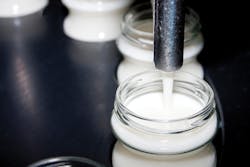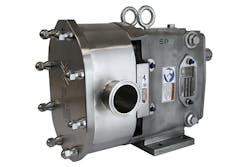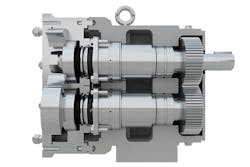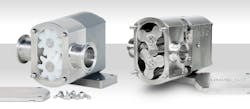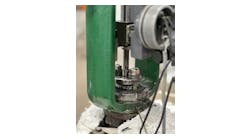Designing positive displacement pumps for modern food safety guidelines
Positive displacement pumps, or PD pumps, have long been used in food processing. Over time, designs have been enhanced to improve pump efficiency and performance across fluids of varying viscosity. With new food safety standards in the process of being introduced, pumps are also advancing in their "cleanability."
PD pumps offer many benefits in food production including smooth, pulse-free pumping and hygienic performance. The use of large rotor fluid cavities and anti-cavitation ports make them ideal for a wide range of applications including highly viscous fluids and/or fluids containing large particles. Some pump models are designed with particularly tight internal tolerances, facilitated through the use of special non-galling internal alloys. These offer low slip performance, which not only increases pumping efficiency but also improves sanitary performance and unit longevity.
Clean-in-place (CIP) PD pumps are readily available with features that enable cleaning without the need for disassembly and reassembly. This saves on maintenance labor hours as well as reduces the risk of processing line errors being introduced if assembly of the pump is not carried out correctly. Developments to improve cleanability, must keep pace with
increasing demands for hygienic performance from the food industry and its regulatory bodies.
Food Safety Modernization Act
Signed into law on Jan. 4, 2011, the Food Safety Modernization Act (FSMA) represents a step by the U.S. Food and Drug Administration (FDA) to increase prevention of foodborne illness. The FSMA recognizes that safety of the food supply is a shared responsibility throughout the global supply chain. With new draft guidance documents issued in January 2018, there is added focus on actually validating a system is clean rather than just certifying that it is cleanable.
Whereas regulatory review processes, such as those conducted by 3A and the European Hygienic Engineering & Design Group (EHEDG), certify a piece of equipment as being designed to be cleanable, each processor needs to validate its processing line to determine a regiment for cleaning and to inspect and validate process lines are being cleaned properly and equipment is clear of contaminants and bacteria. Such validation pursuant to the FSMA is a critical factor for enhancing food safety.
Waukesha Universal 3 Positive Displacement Pump with front-loading seal design. Image courtesy of SPX FLOW Inc,
Enhancement to PD pumps for improved cleanability
Responding to the shift in focus by the FDA with the FSMA, pump manufacturers are working to continually improve the cleanability and increase the hygiene of customer products when using their pumps, while ensuring easy maintenance. One such enhancement includes redesign of the front-loading seal area. This was required because some front-loaded PD pump seals resided within the pump head, which created a risk where the seals could fracture, break or wear and lead to worn seal components ending up in the pumped product. Another area of weakness with existing pump designs was the dead space (where the rotor nuts reside) in the front cover. Here, CIP fluid velocity was lower and cleaning not as thorough, product flow also could be stagnant in this area allowing the product to solidify or separate. This created issues for the hygienic performance of the pump. It is still common practice in the industry to use O-ring seals, which have a tendency to trap products and become a source of contaminant for
product flows.
To address these specific issues, pumps such as the Waukesha Cherry-Burrell (WCB) Universal 3 Series now incorporate a seal design that is located in the back of the pump body, so while it is accessible from the front, should it wear or break it will be forced out of the pump in the open area between the pump body and gear case. The seal design also incorporates a profiled gasket instead of an O-ring seal on the front cover. This creates a tight seal against the cover and body of the pump and leaves no crevices where product can hide. The design also eliminates the dead space behind the front cover, so CIP fluid velocity can be maintained and better cleaning results achieved. These changes alone have proved to be a big step forward in the hygienic performance of PD pumps.
Marrying maintenance with cleanability
Manufacturers require their pump installations to perform on several levels. These include efficiency, consistent performance, reliability, cleanability and ease of maintenance. It makes sense, for example, to use front-loading pumps that have seals that can be easily inspected and replaced without the need to remove the full pump body. This reduces maintenance time and facilitates easier inspection to validate cleaning. Spares holding is another area where careful design of a product range can offer plants the ability to reduce the total number of different spare parts they hold. Overall, easy maintenance and inspection helps to keep the pump operating efficiently, maximizes uptime and helps with validating cleanability.
The Waukesha Universal 3 Pump is designed with features to enhance cleanability and run times. Image courtesy of SPX Flow Inc.
Application examples
One manufacturer of yogurts had issues with seeds from the fruit in the product becoming trapped in the front cover area. The use of the latest PD pump design with a flat, profiled gasket and reduced dead space in the front cover area offered this user significant improvements in cleanability and reduced maintenance with longer seal life.
Another producer of baby food required PD pumps to move its highly viscous, lumpy product but cleanability and ease of maintenance was of paramount importance. Again, the improved cleanability and reduced spares requirements of the latest PD pump designs offered this manufacturer clear benefits.
Apotek Solutions LLC is a solutions provider that specializes in egg processing and brewing technology. For its liquid egg processing solutions, Santiago Gomez, director of technology at Apotek, said, "The enhancements to PD pump technology as seen in the Universal 3 Series have a lot of appeal. I like the fact that the pump has superior cleanability, which reduces any risks to food safety; and how easy the pump is to maintain with the new front loading seal design. The reduced overhung load within the pump and the anticipated longer seal life also reduces the total cost of ownership for this pump and helps ensure our machines continue to run reliably for longer periods. I think these are great advantages for our customers."
Other pump features & their benefits
Other areas of PD pump design that enhance food safety include complete sealing of the rotor and shaft from the product zone. This not only reduces the risk of contamination of the product, but also reduces the risk of internal corrosion, especially with acidic or abrasive product lines.
Reliability is another vital area for pump selection. Features that can extend pump life include positive lubrication of bearings, use of double-tapered bearings and a robust frame design. Not having bearings in contact with process fluids further maximizes service life even for nonlubricating fluids. Pumps that use shorter, larger diameter shafts further reduce overhung loads to protect pump internals, improve seal life and produce greater torque capacity.
Summary
Food safety has always been a top priority. While the FDA is refreshing the focus on how to achieve this, it makes sense for pump manufacturers to increase the cleanability of proven pump designs.
Such developments offer manufacturers a way to reduce risks to product safety while lowering their costs with extended runtimes and shorter CIP cycles. In other words, everyone wins.
Jeff Sporer is Americas Technical Sales Leader for SPX Flow Technology – Food and Beverage and SPX FLOW Inc. Based in Charlotte, North Carolina, SPX FLOW Inc. innovates with customers to help feed and enhance the world by designing, delivering and servicing high-value solutions at the heart of growing and sustaining diverse communities. The company’s product offering is concentrated in rotating, actuating and hydraulic technologies, as well as turnkey systems, in the food and beverage, industrial and power and energy end markets.
